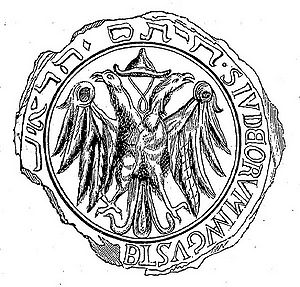
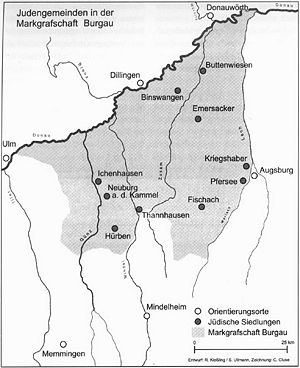
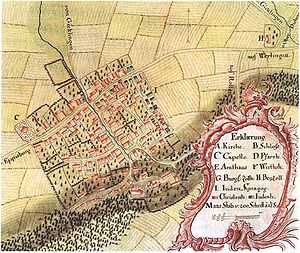
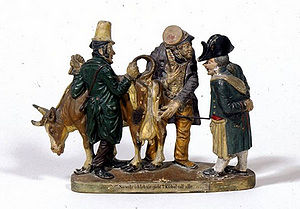
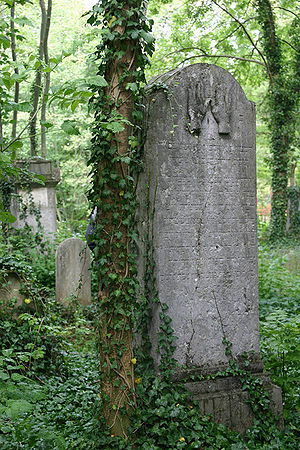
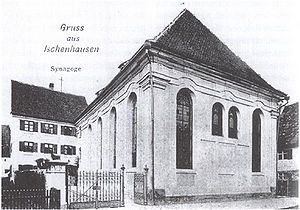
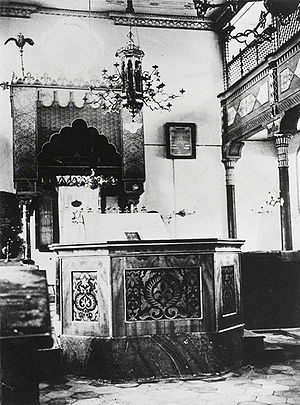
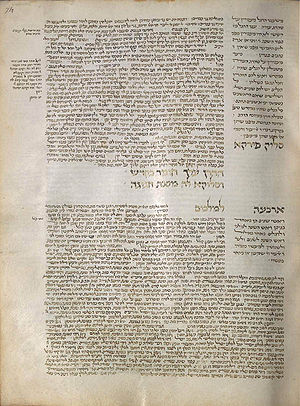
Today's Bavarian administrative district of Swabia, along with Franconia, Alsace and the Middle Rhine region, was one of the central settlement areas of Judaism in the Holy Roman Empire during the Late Middle Ages and the Early modern period. The Jewish history of this region therefore displays specific influences and lines of development. In addition to the break in settlement history that was the change from the urban Judaism of the Middle Ages to the rural Judaism of the Early modern period, its most characteristic features are the various forms of Jewish community life as well as expulsions and resettlements. With the assimilation that began at the end of the 18th century, as well as legal equality in the course of gradual emancipation since 1813, the general conditions changed fundamentally, meaning the beginning of the 19th century marked a profound turning point.
Urban Judaism in the Middle Ages
The first evidence of Jewish settlements in Swabia can be found in its Imperial Cities, amongst which Augsburgplayed a prominent role. A Jewish community is documented here from the first half of the 13th century, and its seal from the year 1298 is preserved. Although the Jews were subject to the king and empire as "imperial chamberlains", their living conditions were essentially determined by the Council committees – sometimes in cooperation with the city lord, sometimes in opposition to him. The basis for the increasing expansion of urban rule over the Jews was the de facto protective function from which the right to supervision and taxation was derived. In addition to trading in goods and the professions related to Jewish community life (including scribe, shohet, teacher, doctor) money lending on a pawn basis was the crucial pillar of the economic structure. In the course of the 14th century, the municipal legal status was finally fixed in the form of a "Jewish civil right", which granted them a right of protection and residence by means of entry in the municipal civil register.
After the "Rintfleisch" pogroms at the end of the 13th century, a catastrophic cut was wrought by persecutions during the Plague years 1348/51, which not only wiped out the Augsburg community, but also numerous other urban communities in Swabia such as Donauwörth (Donau-Ries district), Lindau, Gundelfingen (Dillingen a. d. Donau district) or Dillingen. Taking place before the plague even appeared, these were not predominantly spontaneous reactions of a population scared by the danger of the epidemic, but rather planned actions, as handed down in the case of Augsburg, for example. The most frequent legitimation – spread by rumour – was that of "well poisoning", which tied in with earlier ideas of the Jews' alleged worldwide conspiracies. Due to the privileges granted by Karl IV (ruled 1346-1378) there was comparatively rapid resettlement in most Swabian cities. This context includes the documents for Kaufbeuren (1377), Kempten (1373), Lindau (1378), Memmingen (1373) and Nördlingen as one of the earliest (1357). Even if the view held in older literature - that Jews were increasingly marginalised and ghettoised upon their return to the cities - is no longer tenable, a deterioration in their legal position as well as in their opportunities for economic development can be observed in the long term. A crucial stage in the economic decline that had now begun was the liquidation of debts by King Wenceslas (ruled 1376-1400, died 1419) 1385/88 and 1390, which declared the claims of the Jews from loan transactions null and void.
Expulsions from the cities
Medieval hostility towards Jews is characterised by a feeling of threat and insecurity and was nourished by anti-Jewish stereotypes, which were mainly religiously based. Among the most powerful were the accusation of desecration of the Eucharist and the accusation of ritual murder. Added to this was the aspect of growing debt, which, with the spread of credit relations, created the image of the Jewish usurer. Before these cultural patterns were well established, the persecution of Jews acted as a sort of lightning rod for social and political grievances in the cities. Eucharistic miracles were passed down, for example, in Lauingen (Dillingen a. d. Donau district) in 1404, and a ritual murder accusation led to the wiping out of the local community in Lindau in 1430.
These bloody forms of persecution were replaced at the end of the Middle Ages by expulsions ordered by the authorities. After the first campaigns in Augsburg 1438/40, Ulm 1499 and Memmingen (probably in the 15th century), Nördlingen (1507), Donauwörth (1518) and Kaufbeuren (1543) followed in the 16th century. Besides the cities, it was the expulsions from the Wittelsbach dukes' larger neighbouring territories (Bavaria-Munich 1442, Bavaria-Landshut 1450, Bavaria as a whole 1553) and from the Duchy of Württemberg in 1498, which had an effect on Swabia. Researchers see the motives in complex inner-city disputes and in the decline of the municipalities' financial power. Subsequently, the rural area between Augsburg and Ulm developed into a refugium for the Jewish communities.
The transition to rural Judaism in the Early modern period was a long-term migration: on the one hand, evidence of scattered village settlements, can be found as early as the Late Middle Ages, on the other hand, the process was by no means immediate. For example, after their expulsion in 1438/40, the Jews of Augsburg first moved to other large cities in the empire that still granted them protection. The village settlements in the area around Augsburg, on the other hand, were only documented in 1553 (Oberhausen), 1560 (Kriegshaber), 1569 (Pfersee) and 1584 (Steppach).
Overall, a clear consolidation of the Jewish settlements in villages and municipalities can be observed since the second half of the 16th century. Although this was still marked by considerable fluctuations in the 16th century, it was cemented by another surge in settlement after the Thirty Years' War. Since the middle of the 17th century, a settlement structure, which was defined by high concentrations centred in only a few places, developed – particularly in the Margraviate of Burgau and in the County of Oettingen. Here, Jews and Christians lived in close proximity and shared the villages as a common social and sacral space, with the Jewish share of the population in some cases rising to as much as 30-40% during the 18th century.
Territorialisation of the protection of Jews
Parallel to these transformations of the settlement structures, the Jewish communities' legal positions changed. In the course of the formation of early modern territorial statehood, the protection of the Jews, initially a royal, urban privilege for the settlement and taxation of Jews, was transferred to the territorial sovereigns. Fiscal and economic motives in the sense of the “Peuplierung” (population increase) as a targeted population policy as demanded by the cameralists were crucial. Despite the increasing concentration of protection rights at territorial level, the emperor remained an effective force in his role as supreme protector. This applies in particular to Swabia, where a close relationship to the emperor and the empire developed due to Habsburg possessions and less powerful imperial estates. The sovereigns and local rulers now also issued their own Jewish legal provisions within the framework of Jewish orders and letters of protection. The motives for regulation were protection against alleged Jewish usury, the regulation of Jewish religious practice in public, smooth tax collection, and general legal protection against discrimination and persecution.
In the margraviate of Burgau, a territorium non clausum, the protection of the Jews was divided between the local aristocracy and the government of the province of Upper Austria until the end of the Holy Roman Empire. Comprehensive regulations at the level of the sovereign rulers stalled after a first attempt in 1534. The decisive factor in Burgau was rather the Jewish law provisions in the treaties (so-called interim means of 1587) and above all the decisions on the level of local rule. In the County of Oettingen, on the other hand, the general conditions of Jewish existence were regulated by an extensive system of protective letters under the participation of the Jewish communities, who expressed their concerns through the supplication procedure. A comparatively large part was devoted to the provisions on Jewish commercial activities. With the relocation to the countryside, the ways of earning a living had also changed, although there are certainly continuities to be observed. The continuing ban on joining commercial guilds or acquiring land ownership meant that the Jewish population was dependent on trade and the credit business. While in the medieval towns of Swabia the credit trade – on a pawn basis – with the nobility and bourgeoisie played a crucial role, in addition to the trade in goods and occasional trade in livestock, there was now a shift to the rural economy. This was associated with a considerable economic decline, as business now took place in the area of retail trade with the farming population. The main focus was on the trade of livestock and small goods, both of which were linked to credit transactions and run in the peddler business.
Jewish community life
The dissolution of the medieval city communities also resulted in a far-reaching fragmentation of Jewish community life. The forced retreat into very small rural dominions where Jews initially settled isolated and sporadically, made it difficult to establish a functioning practice of faith in the 16th century. In addition to attempts at the imperial level, signs of reorganisation in the late 16th century can be identified in smaller-scale contexts. "Medinats" (States) were formed in the form of local authorities, which were based on the historically developed settlement contexts. The core of this new form of communal self-organisation was formed by the rabbinate seats, which could tie a certain surrounding area to themselves by virtue of the authority of their owners. The Medinat of Swabia represented a geographical link in the area between Augsburg and Ulm that was tangible comparatively early on. A state rabbi, Jona ben Jakob Weil, held office in Günzburg as early as 1525. During the 16th century, this court was one of the five most important ones in the empire, being the seat of a number of famous scholars such as Isaak ben Josef Segal (around 1530-1567/68) or Jakob Reiner (after 1568). After being expulsed from Günzburg by Margrave Karl von Burgau (1560-1618) in 1617/18, the court moved firstly to Burgau, then to Thannhausen (Günzburg district) before it was able to establish itself in Pfersee (Augsburg district).
Apart from the rabbinates, the cemeteries, which in the countryside always served as burial places for several Jewish settlements in a district, had a similar function of creating Jewish areas. For the 16th century, Jewish cemeteries can be evidenced in Burgau, Ichenhausen, Neuburg a.d. Kammel and Thannhausen (all Günzburg district). Among the burial grounds after the Thirty Years War, the cemetery in Kriegshaber had the largest catchment area. Ichenhausen had its own burial places since 1567, Hürben (Krumbach municipality, Günzburg district) since 1628, Buttenwiesen since 1632/33 and Binswangen (both Dillingen a. d. Donau district) since 1663.
Finally, the extremely high Jewish population concentrations in individual villages allowed for a relatively early establishment of independent religious communities at the local level in Swabia. This is signified by the construction and maintenance of community buildings and the presence of local rabbis and community servants. The beginnings of the Swabian rural synagogue architecture, which reached its pinnacle mostly in the late 18th and early 19th century, therefore date back to the 17th century, for example in Binswangen.
References
- Peter Fassl (Hg.), Geschichte und Kultur der Juden in Schwaben. 3 Bände, Sigmaringen/Stuttgart 1994-2007.
- Friedrich J. Battenberg, Die Juden in Deutschland vom 16. bis zum Ende des 18. Jahrhunderts (Enzyklopädie deutscher Geschichte 60), München 2001.
- Rolf Kießling (Hg.), Judengemeinden in Schwaben im Kontext des Alten Reiches (Colloquia Augustana 2), Berlin 1995.
- Arye Maimon/Mordechai Breuer/Yacov Guggenheim (Hg.), Germania Judaica. Band III, Teilbände 1-3, 1350-1519, Tübingen 1987, 1995, 2003.
- Johannes Mordstein, Selbstbewusste Untertänigkeit. Obrigkeit und Judengemeinden im Spiegel der Judenschutzbriefe der Grafschaft Oettingen 1637-1806 (Veröffentlichungen der Schwäbischen Forschungsgemeinschaft. Reihe 11: Quellen und Darstellungen zur jüdischen Geschichte Schwabens 2), Epfendorf 2005.
- Stefan Rohrbacher, Stadt und Land: Zur „inneren“ Situation der süd- und westdeutschen Juden in der Frühneuzeit, in: Monika Richarz/Reinhard Rürup, Jüdisches Leben auf dem Lande. Studien zur deutsch-jüdischen Geschichte (Schriftenreihe wissenschaftlicher Abhandlungen des Leo Baeck Instituts 56), Tübingen 1997, 37-58.
- Michael Toch, Spätmittelalterliche Rahmenbedingungen jüdischer Existenz: Die Verfolgungen, in: Sabine Hödl/Peter Rauscher/Barbara Staudinger (Hg.), Hofjuden und Landjuden. Jüdisches Leben in der Frühen Neuzeit, Wien 2004, 19-64.
- Sabine Ullmann, Nachbarschaft und Konkurrenz. Juden und Christen in den Dörfern der Markgrafschaft Burgau 1650 bis 1750 (Veröffentlichungen des Max-Planck-Instituts für Geschichte 151), Göttingen 1999.
Further Research
Related Articles
Cite
Sabine Ullmann, Judaism in Swabia (until 1800), published 25 September 2013, English version published 06 March 2024; in: Historisches Lexikon Bayerns, URL: <https://www.historisches-lexikon-bayerns.de/Lexikon/EN:Judaism_in_Swabia_(until_1800)> (20.12.2025) [[Kategorie:Anfang 16. bis Ende 18. Jh.]
